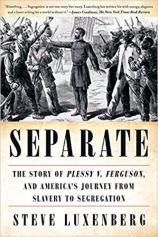Separate: The Story of Plessy v. Ferguson, and America's Journey from Slavery to Segregation
Review
Separate: The Story of Plessy v. Ferguson, and America's Journey from Slavery to Segregation
Regardless of ideology, there’s a relatively short list of United States Supreme Court cases that deserve to be included in any legal Hall of Shame. One is Dred Scott v. Sandford, holding that slaves were the property of their owners and not citizens of the United States. A second is Korematsu v. United States, upholding the internment of Japanese-American citizens during World War II. And a third --- falling roughly at the midpoint between these two odious decisions --- is Plessy v. Ferguson, the 1896 case in which the court, with only one justice dissenting, rejected a challenge to a Louisiana statute that mandated “equal but separate accommodations for the white and colored passengers traveling on trains in the state.”
Now, in SEPARATE, a work of impressive scope, depth and sensitivity, longtime Washington Post senior editor Steve Luxenberg (ANNIE’S GHOSTS) revisits the historical and legal roots of Plessy. Acknowledging that he’s “not a legal scholar or a constitutional historian,” Luxenberg describes himself as a “storyteller with a passion for narrative history.” But as he immerses himself deeply in the extensive documentary record, he demonstrates both a mastery of those disciplines and a skill at evoking a vivid sense of America's bitter struggles over civil rights in the 19th century. Even before its publication, his talent was recognized, when SEPARATE won the 2016 J. Anthony Lukas Work-in-Progress Award.
"Anyone who wants to understand Plessy in its own time and in the decades that followed will find Steve Luxenberg’s SEPARATE an ideal starting point."
Though this reality is often obscured by legal arcana, many important Supreme Court cases have a deeply human essence. In traversing some six decades of American history, Luxenberg wisely has chosen to ground his narrative in the stories of four principal characters: Supreme Court justices Henry Billings Brown, the author of the Plessy majority opinion, and John M. Harlan, the sole dissenter; Albion Tourgée, lead counsel for Homer Plessy; and Louis Martinet, head of the Citizens Committee to Test the Constitutionality of the Separate Car Law in New Orleans. These men moved “on separate paths to a shared destination, connected by time, culture, happenstance, and the unresolved struggle between an exhausted North and a bitter South.”
Luxenberg is a leisurely narrator, and doesn’t settle fully into the story of Plessy --- from its inception a carefully engineered test case intended to reach the Supreme Court --- until the final 100 pages of the book. But all that precedes the account of the case’s protracted path to a resolution (nearly four years elapsed from the decision of the Louisiana Supreme Court to the Supreme Court’s ruling) is essential to understanding it. Most critical to that understanding is that, when it came to the origins of the Jim Crow laws, it was the “free and conflicted North that gave birth to separation, in different places and in different forms.”
Reviewing cases from Massachusetts, Michigan and Pennsylvania, Luxenberg thoroughly describes how the practice of separation in public transportation agitated northern lawmakers and courts long before it became an issue in the post-Civil War South. That region, he explains, was insulated from the need to confront the issue in the era of slavery, a time that required "close contact, coercion, and even intimacy to survive and prosper." Indeed, all but one of the members of the Plessy majority hailed from Northern states, a fact that might surprise readers who could be excused for assuming that the decision was the product of a group of embittered Southerners, fanning the embers of revenge.
Of his quartet of protagonists, Harlan and Tourgée are clearly the most complex and fascinating. Born into a slaveholding family in Kentucky, though he fought for the Union in the Civil War, Harlan’s views on racial equality evolved from his early days in public life in the turbulent 1850s as a member of the anti-immigrant Know Nothing (later American) Party. By 1883, he was the author of a vigorous dissent in the Civil Rights Cases, the 8-1 ruling that struck down the Civil Rights Act of 1875, foreshadowing the Court's decision in Plessy.
Ohioan Tourgée, also a Civil War veteran, lived a colorful and peripatetic life that included 14 years in post-war North Carolina, where he ran unsuccessfully for Congress, served as a judge and became a "potent force in North Carolina's Republican Party." A prolific writer, he published a bestselling novel about Reconstruction, A FOOL’S ERRAND, BY ONE OF THE FOOLS, and wrote a nationally circulated column under the pen name “the Bystander,” which made him, in Luxenberg's view, "arguably, the best-known white advocate for civil rights in the country." Tourgée was the lawyer responsible for crafting the ultimately unsuccessful arguments in Plessy, ones that failed utterly, as Luxenberg explains, though not in any way owing to a lack of originality.
Until 1954, when a unanimous Supreme Court, in Brown v. Board of Education, ruled that “separate educational facilities are inherently unequal,” Plessy's legal blessing of segregation spawned more than half a century of racial division and conflict, not only in the South but also throughout the United States. For all the good done by that reversal, Brown could not erase the long shadow of Plessy and its toxic legacy. Anyone who wants to understand Plessy in its own time and in the decades that followed will find Steve Luxenberg’s SEPARATE an ideal starting point.
Reviewed by Harvey Freedenberg on February 15, 2019
Separate: The Story of Plessy v. Ferguson, and America's Journey from Slavery to Segregation
- Publication Date: February 4, 2020
- Genres: History, Nonfiction
- Paperback: 624 pages
- Publisher: W. W. Norton & Company
- ISBN-10: 0393357694
- ISBN-13: 9780393357691




